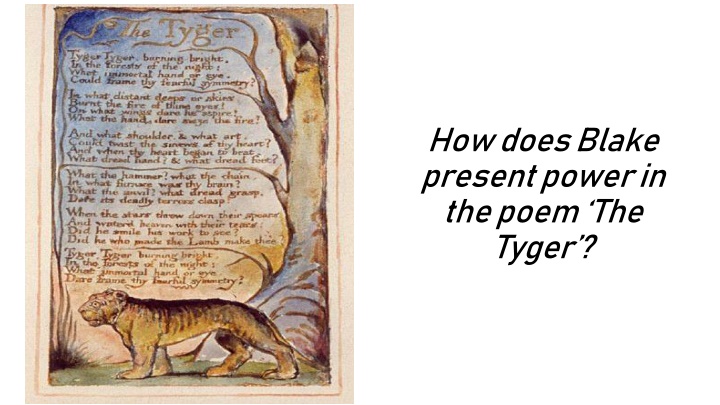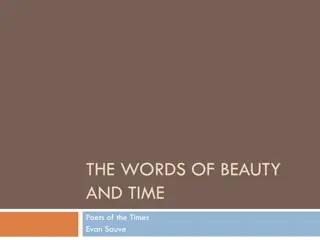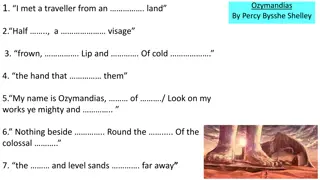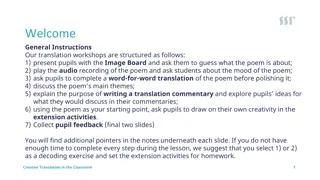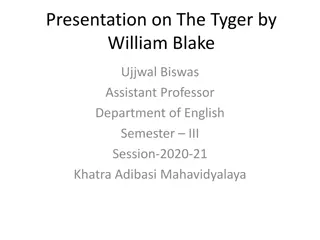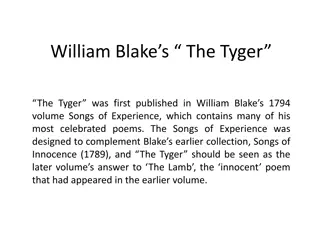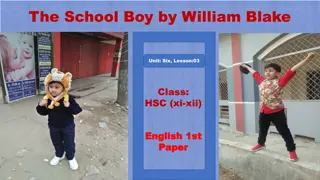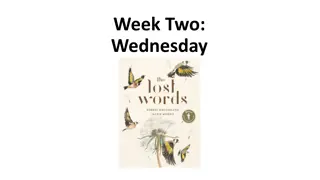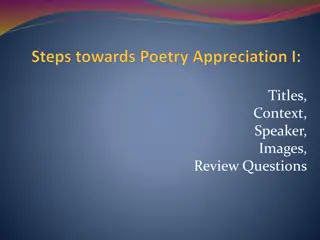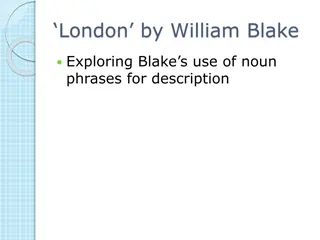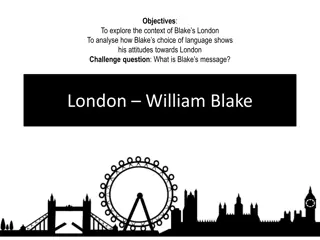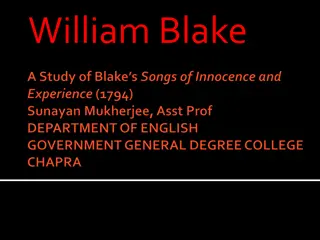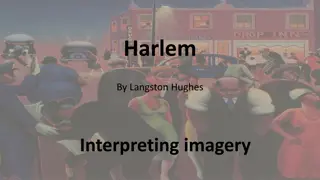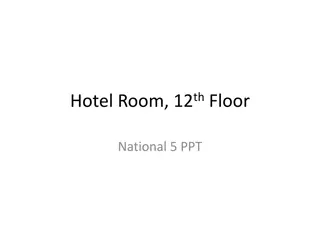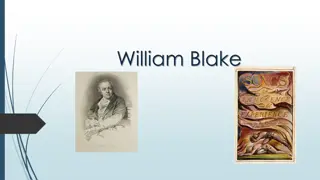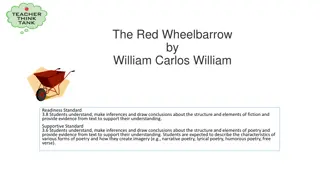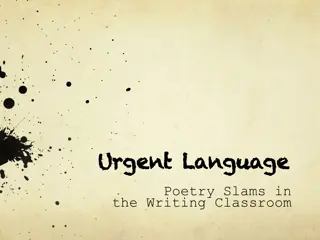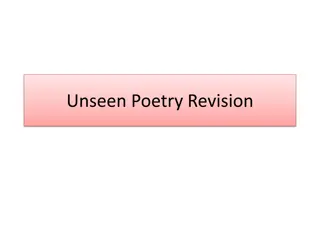Analyzing Power in William Blake's Poem "The Tyger
Explores how William Blake presents power through the depiction of the fierce and beautiful tiger in his poem "The Tyger." The analysis delves into the imagery, symbolism, and awe-inspiring nature of the tiger, emphasizing the concept of divine creation and the duality of existence.
Download Presentation

Please find below an Image/Link to download the presentation.
The content on the website is provided AS IS for your information and personal use only. It may not be sold, licensed, or shared on other websites without obtaining consent from the author.If you encounter any issues during the download, it is possible that the publisher has removed the file from their server.
You are allowed to download the files provided on this website for personal or commercial use, subject to the condition that they are used lawfully. All files are the property of their respective owners.
The content on the website is provided AS IS for your information and personal use only. It may not be sold, licensed, or shared on other websites without obtaining consent from the author.
E N D
Presentation Transcript
How does Blake present power in the poem The Tyger ?
William Blake is a famous English poet and artist. He was born into a working class London family and only attended school until he was ten years old. He was an early influence upon the Romantic Movement in art which tried to redress the dehumanising effects of the Industrial Revolution through a return to nature and the past. Blake was a radical and original thinker who admired the ambitions of the French and American Revolutions to bring equality to the masses. He was also a committed Christian whose non-conformist faith is evident in many of his works. William Blake William Blake His most famous poems were published in 1794, called Songs of Innocence and Experience. The book contained two collections of poems; one was called Innocence and the other Experience. The Songs juxtapose poems which contrast a childlike perception of the world, with poems about the loss of that innocent view.
Background and summary The Tyger is located in the Experience section of the Songs . It is therefore part of the grouping of poems told from the point of view of an experienced speaker who has lost a childlike view of the world. In the 1790s in London there were few opportunities to see tigers. Therefore the animals had a mythic status as powerful beasts. The spelling of tiger is odd in the poem because at the time Blake was writing the spellings of words had not yet been fixed. The poem is spoken directly to a tiger. The speaker asks the tiger what sort of a creator would make an animal which is both beautiful and deadly. The poem dwells on this thought, but never provides an adequate answer. Instead, it communicates the poet s wonder at the way God is responsible for bringing both goodness and evil to mankind.
How does Blake present power in the poem The Tyger ?
1. Firstly, the power of the tiger is shown. Capitalisation and epizeuxis of Tyger: Tyger, Tyger The tyger is being directly addressed. Example of an apostrophe a speech to a person who is not present. More terrifying atmosphere of forest hints at mystery of creation. Alliterative burning bright The imagery here is in reference to the coat of the tyger. Amidst the green of the forest, the orange and black of the tyger clearly stands out. 1 2 Tyger, Tyger, burning bright, In the forests of the night: Noun: forests Interpreted as a symbol of human subconscious / unconscious. Dark / mysterious But the repetition of Tyger and the alliterative burning bright means that a rhythm of movement is created to imagine the tyger moving through the forest. Adjective: fearful To illustrate that the tyger is something to be afraid of designed to inflict pain and kill. The speaker is in awe of God s creation the noun symmetry suggesting it s beauty suggesting that the tyger was not created by accident, it is artistry.. 4 Could frame thy fearful symmetry The fiery imagery could also refer to the aggression, fierce nature of the tiger.
2. The power of the creator is discussed. Adjective immortal Raises the question as to whether the creator is God like. Rhetorical questions What immortal hand or eye / Could frame thy fearful symmetry? The whole poem is structured using a series of rhetorical questions. This is because the writer is trying to understand who would create such a creature 3 4 What immortal hand or eye, Could frame thy fearful symmetry? What here is asking who? Verb phrase could frame Trying to understand the motivation behind creating such a creature. The reference to frame alludes to Blake who was an engraver before he became a poet.
2. The power of the creator is discussed. Verb phrase burnt the fire Again the fire imagery alludes to hell. Noun phrases: distant deeps / distant skies The question being asked here is where was the creature created. Distant deep could refer to hell whilst distant skies could refer to heaven. Does the creation of the tyger therefore come from someone / some place good or someone / some place bad? Alliterative distant deep helps reinforce the depth To burn with fire means to feel inspired or engaged so this could be asking where did you passionately create your work. 5 6 In what distant deeps or skies Burnt the fire of thine eyes? The question of why this was such a passionate creation could be raised. 7 8 On what wings dare he aspire? What the hand dare seize the fire? Rhetorical question: What the hand dare seize the fire? Whose hand grabbed the fire to create the being? The physical power of the creator is emphasized here. The verb dare is repeated throughout to convey the idea that creating something so powerful and so potentially destructive is a brave thing to do. Noun: wings reference to angels virtuous angels fallen like Satan allusion to Icarus ambition but potential ambition leading to a downfall.
2. The power of the creator is discussed. Noun: art reference to the creativity needed in order to create being. Remembering that Blake was an engraver an artist. Noun: shoulder reference to physicality here and the strength and power needed of the creator in order to create the being 9 10 And what shoulder, and what art, Could twist the sinews of thy heart? Clause: What art / could twist the sinews of thy heart moment of creation like sculpture bringing the tiger to life. 11 12 And when thy heart began to beat, What dread hand? & what dread feet? Repetition: dread the courage needed to create the being- the courage to see the creation through. The strength. The use of shoulder and art emphasizes the physical and emotional pull to create the tiger as well.
2. The power of the workroom is presented. Noun: furnace Could also be a reference to industrialization. Blake was writing during the period of the Industrial Revolution. The poet is asking what tools were used to create. Semantic field of tools: hammer , chain , anvil reference to the craftmanship (links potentially again to his work as an engraver). 13 14 What the hammer? What the chain, In what furnace was thy brain? Furnace could also be another reference to hell as it is fiery and hot. 15 16 What the anvil? What dread grasp Dare its deadly terrors clasp! Repetition: dread the courage needed to create the being Exclamation mark: the line ending with an exclamation mark reveals the writer feels this is something that terrifies him the thought that someone would create something so deadly. The verbs grasp + clasp could refer to the power of the Tiger as a hunter and how an encounter like that could be deadly so it s a brave thing to create.
2. The power of the creator is discussed. Personification: and water d heaven with their tears cried as they realized that God had created the Tiger. Personification: stars threw down their spears when they saw what God had created, they retreated and surrendered to him. Reference to Fallen Angels in Paradise Lost? 17 18 When the stars threw down their spears And water d heaven with their tears: Rhetorical question: Did he who made the Lamb make thee? The Lamb is another poem taken from Blake s Songs of Innocence and Experience. He is questioning whether someone who can create something so gentle can also create something so fierce. 19 20 Did he smile his work to see? Did he who made the Lamb make thee? Rhetorical question: Did he smile his work to see? Was he proud of what he had created?
1. The power of the creator is discussed. Alliterative burning bright The imagery here is in reference to the coat of the tyger. Amidst the green of the forest, the orange and black of the tyger clearly stands out. Refrain: Tyger, Tyger resolution. Lots of questions raised for the reader to ponder as we return to the original image of what has been created. 21 22 Tyger, Tyger, burning bright, In the forests of the night: But the repetition of Tyger and the alliterative burning bright means that a rhythm of movement is created to imagine the tyger moving through the forest. 23 24 What immortal hand or eye, Dare frame thy fearful symmetry? Verb: dare the only change from the first stanza to this stanza is the verb could to dare . Daring is an evident theme throughout who would be brave enough to create something so destructive. But as an artist himself, Blake could also be that the daring is being creative and that creations need to be daring if they are to have any power or change anything. Fundamentally, something as ferocious as the tiger is needed to counteract the lamb and vice verse. One cannot exist without the other. The fiery imagery could also refer to the aggression, fierce nature of the tiger.
Structure Structure Six quatrains stanzas of four lines End-stopped punctuation at the end of the line Rhetorical questions symbolic of all the things in humanity that we find hard to understand Regular rhyme scheme rhythmic, rhythm of work, rhythm of Tiger moving through the forest etc.
How does Blake present power in the poem The Tyger ?
